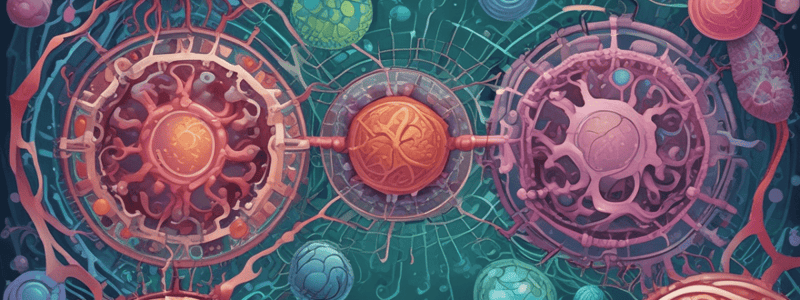Podcast
Questions and Answers
What is a characteristic that distinguishes eukaryotic cells from prokaryotic cells?
What is a characteristic that distinguishes eukaryotic cells from prokaryotic cells?
- Presence of a nucleus (correct)
- Ability to outcompete other cells
- Lack of internal organisation
- Presence of cell walls
What is the primary function of the replication complex in viral replication?
What is the primary function of the replication complex in viral replication?
- To release the viral RNA into the host cell
- To hijack the host cell's machinery
- To translate viral RNA into proteins
- To make more RNA (correct)
What is the purpose of the enzyme that helps the virion enter the host cell?
What is the purpose of the enzyme that helps the virion enter the host cell?
- To bind the virion to the cell surface protein
- To translate the viral RNA into proteins
- To protect the viral genome from the host cell's immune system
- To release the viral RNA into the host cell (correct)
What is the main difference between prokaryotic and eukaryotic cells in terms of their internal structure?
What is the main difference between prokaryotic and eukaryotic cells in terms of their internal structure?
What is the role of the Golgi apparatus in the viral replication cycle?
What is the role of the Golgi apparatus in the viral replication cycle?
What is the characteristic that defines viruses as being 'alive' or 'not alive'?
What is the characteristic that defines viruses as being 'alive' or 'not alive'?
What is the primary reason why viruses require larger cells to function?
What is the primary reason why viruses require larger cells to function?
What is the role of the ACE2 protein in the SARS-CoV-2 viral cycle?
What is the role of the ACE2 protein in the SARS-CoV-2 viral cycle?
What is the primary advantage of compartmentalization in eukaryotic cells?
What is the primary advantage of compartmentalization in eukaryotic cells?
What is the primary difference between prokaryotic and eukaryotic cells in terms of their metabolism?
What is the primary difference between prokaryotic and eukaryotic cells in terms of their metabolism?
What is the function of the RNA translated into proteins by the host cell's machinery?
What is the function of the RNA translated into proteins by the host cell's machinery?
What is the characteristic that distinguishes viruses from other forms of life?
What is the characteristic that distinguishes viruses from other forms of life?
What is the primary function of the cell surface proteins in the context of viral infection?
What is the primary function of the cell surface proteins in the context of viral infection?
What is the primary advantage of having a nucleus in eukaryotic cells?
What is the primary advantage of having a nucleus in eukaryotic cells?
What is the primary characteristic that distinguishes prokaryotic cells from eukaryotic cells?
What is the primary characteristic that distinguishes prokaryotic cells from eukaryotic cells?
What is the role of the lipids in the membranes surrounding prokaryotic and eukaryotic cells?
What is the role of the lipids in the membranes surrounding prokaryotic and eukaryotic cells?
Study Notes
Cellular Function and Diseases
- Diseases can arise from cells malfunctioning or failing to function properly.
- Viruses are acellular and significantly smaller than prokaryotic cells.
- Viruses exploit larger host cells by attaching to surface proteins and injecting their RNA.
Viral Mechanism
- Example: SARS-CoV-2 uses its spike protein to bind to the ACE2 receptor on host cells.
- An enzyme facilitates the entry of the virus, releasing viral RNA into the cell.
- The cell machinery translates some of the viral RNA into proteins.
- A replication complex forms to create additional RNA.
- Newly synthesized proteins and RNA assemble into virions in the Golgi apparatus and are released from the cell.
Prokaryotic vs. Eukaryotic Cells
- Prokaryotes, including bacteria and archaea, are simpler, smaller, and lack a defined nucleus; their DNA floats within the cell.
- Eukaryotes are larger and more complex, characterized by the presence of a nucleus, which protects the DNA and genome.
- Eukaryotic cells contain various organelles, each performing specialized functions to enhance cellular efficiency.
Compartmentalization
- Eukaryotic cells utilize compartmentalization to manage size and support rapid metabolic reactions, increasing overall efficiency.
Diversity of Life
- Life forms consist of single-celled organisms (both prokaryotes and eukaryotes) and multicellular organisms, including invertebrates, vertebrates, plants, and humans, all based on cellular structures.
Evolution and Metabolism
- Life is defined by evolution through natural selection.
- All living organisms are separated from their environment by cell membranes, which are essential for metabolic activity, growth, and reproduction.
Life Cycle of Viruses
- Viruses exist in a unique state, oscillating between being classified as alive and not alive, depending on their ability to hijack cellular mechanisms for replication.
Studying That Suits You
Use AI to generate personalized quizzes and flashcards to suit your learning preferences.
Description
This quiz covers the basics of viruses, including their structure, function, and how they interact with cells. Learn about how viruses hijack cellular processes to replicate and the role of cell surface proteins in this process.




